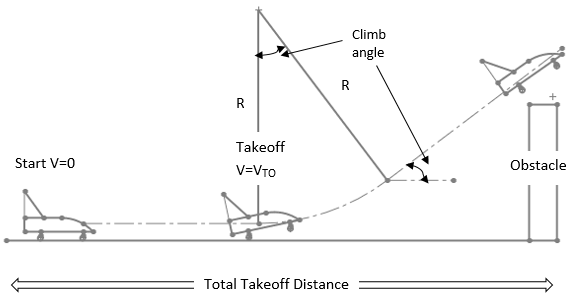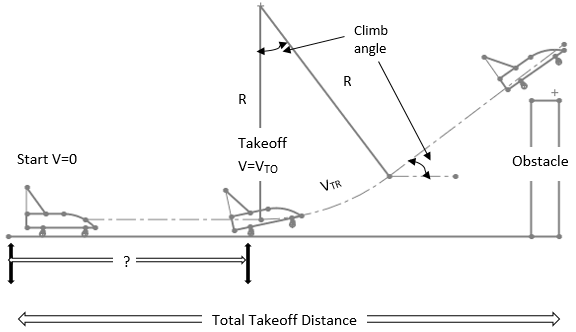This set of Aircraft Design Multiple Choice Questions & Answers (MCQs) focuses on “Flight Mechanics – Takeoff Analysis”.
1. Following diagram represents ____________

a) segments of typical takeoff
b) landing phase
c) cruise to climb mission segment
d) approach
View Answer
Explanation: Above diagram is illustrating the typical segments of a typical takeoff. As shown takeoff segment is subdivided into number of segments such as ground roll, transition etc. After ground roll aircraft follows a near circular arc until it reaches climb angle as shown.
2. Segment marked by ‘?’ in the diagram is called ________

a) typical ground roll
b) cruise path
c) flight path angle
d) free stream velocity
View Answer
Explanation: A typical ground roll is shown in the diagram. Ground roll is further subdivided as level ground roll and the ground roll during rotation to AOA for liftoff. During ground roll, aircraft may experience drag, Thrust, friction on wheels etc.
3. Which of the following is not part of takeoff?
a) Ground roll
b) Transition
c) Climb
d) Descending
View Answer
Explanation: Takeoff segment is subdivided into number individual segments or sections. These segments are ground roll, transition, climb etc. Descending is not the part of takeoff.
4. Determine the acceleration of an aircraft which is in ground roll segment. Consider weight of the aircraft as 150kN, thrust as 110kN and drag as 10kN. Assume weight on the wheels as 60kN and rolling friction as 0.05.
a) 5.68 m/s2
b) 100kN
c) 100 m
d) 3.5689 Kg*m/s
View Answer
Explanation: Given, weight W=150KN, thrust T=100KN, drag D = 10KN, rolling friction f= 0.05, weight on wheels w = 60KN.
Acceleration a = g*(T- D – f*w)/W
= 9.81(100 -10-0.05*60)/150
= 9.81*87/150 = 5.68 m/s2.
5. Which of the following is correct?
a) Ground roll = 0.5 * \(\int_{Vi}^{Vf}(\frac{1}{a})dV^2\)
b) Ground roll = \(\int_{Vi}^{Vf}(\frac{1}{a})dV^2\)
c) Ground roll = 0.5 / \(\int_{Vi}^{Vf}(\frac{1}{a})dV^2\)
d) Ground roll = \(\int_{Vi}^{Vf}dV^2\)
View Answer
Explanation: A typical ground roll distance can be determined by using integration. If we integrate velocity divided by acceleration as shown by the above equation then, we can easily determine ground roll distance. Hence, ground roll distance is given by, Ground roll = 0.5 * \(\int_{Vi}^{Vf}(\frac{1}{a})dV^2\)
Where, V is velocity and a = acceleration.
6. If stall speed of the aircraft is 10m/s then, find the approximate value of takeoff speed.
a) 11m/s
b) 1m/s
c) 9m/s
d) 7m/s
View Answer
Explanation: Takeoff speed = 1.1*stall speed = 1.1*10 = 11m/s.
7. If our design has takeoff velocity of 120 knots then, at which value of stall speed we should design our aircraft?
a) 109.08knots
b) 110 knots
c) 150 knots
d) 125 knots
View Answer
Explanation: Stall speed = 0.909*Takeoff speed = 0.909*120 = 109.08 knots.
8. Find liftoff distance for an aircraft which has weight of 20kN and thrust of 8kN. Consider thrust is much larger than drag and friction parameters. Consider maximum lift coefficient of 1.1, reference area of 12m2 and sea-level density.
a) 454m
b) 1000m
c) 12m
d) 12.12m
View Answer
Explanation: Given, Weight W = 20KN, Density d = 1.225 kg/m3, maximum lift coefficient CL = 1.1, reference area S = 12 m2, Thrust T = 8KN
Liftoff distance = 1.44*W2/ (g*d*S*CL*T) = 1.44*(200002) / (9.81*1.225*1.1*12*8000) = 453.89 = 454m.
9. Find the average velocity at transition if, stall speed is 15 unit.
a) 17.25 unit
b) 19 unit
c) 30 unit
d) 45 unit
View Answer
Explanation: Average velocity = 1.15*stall speed = 1.15* 15 = 17.25 unit.
10. If climb speed during takeoff is 120 unit then, find stall speed.
a) 100knots
b) 240knots
c) 1267knots
d) 215knots
View Answer
Explanation: Stall speed = climb speed / 1.2 = 120/1.2 = 100knots.
11. If Stall speed is 140fps then, find approximate radius of transition arc.
a) 4018 feet
b) 5015 km
c) 1m
d) 10cm
View Answer
Explanation: Approximate value of radius of transition arc in feet = 0.205*Stall speed2
= 0.205*140*140
= 4018 feet.
12. Find the horizontal distance travelled during transition segment. Consider radius of transition arc is 2km and thrust loading is 0.6 and L/D is 5.
a) 800m
b) 8000m
c) 80m
d) 0.80m
View Answer
Explanation: Given, transition arc r = 2km, Thrust loading t = 0.6, and L/D = 5
Now, the horizontal distance H = r*(t – D/L)
= 2*(0.6-0.2) = 0.8 km = 800m.
Sanfoundry Global Education & Learning Series – Aircraft Design.
To practice all areas of Aircraft Design, here is complete set of 1000+ Multiple Choice Questions and Answers.
If you find a mistake in question / option / answer, kindly take a screenshot and email to [email protected]
- Check Aeronautical Engineering Books
- Practice Aerospace Engineering MCQs
- Check Aircraft Design Books
- Practice Aeronautical Engineering MCQs
- Apply for Aerospace Engineering Internship
